Related Research Articles

Robert Anson Heinlein was an American science fiction author, aeronautical engineer, and naval officer. Sometimes called the "dean of science fiction writers", he was among the first to emphasize scientific accuracy in his fiction, and was thus a pioneer of the subgenre of hard science fiction. His published works, both fiction and non-fiction, express admiration for competence and emphasize the value of critical thinking. His plots often posed provocative situations which challenged conventional social mores. His work continues to have an influence on the science-fiction genre, and on modern culture more generally.
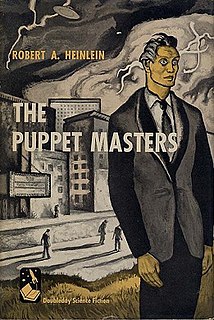
The Puppet Masters is a 1951 science fiction novel by American writer Robert A. Heinlein, in which American secret agents battle parasitic invaders from outer space. It was originally serialized in Galaxy Science Fiction.

The Moon Is a Harsh Mistress is a 1966 science fiction novel by American writer Robert A. Heinlein about a lunar colony's revolt against absentee rule from Earth. The novel illustrates and discusses libertarian ideals. It is respected for its credible presentation of a comprehensively imagined future human society on both the Earth and the Moon.
"Life-Line" is a short story by American author Robert A. Heinlein. Published in the August 1939 edition of Astounding, it was Heinlein's first published short story.
"The Green Hills of Earth" is a science fiction short story by American writer Robert A. Heinlein. One of his Future History stories, the short story originally appeared in The Saturday Evening Post, and it was collected in The Green Hills of Earth. Heinlein selected the story for inclusion in the 1949 anthology My Best Science Fiction Story. "The Green Hills of Earth" is also the title of a song mentioned in several of Heinlein's novels.
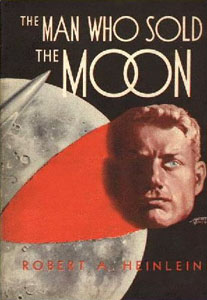
"The Man Who Sold the Moon" is a science fiction novella by American author Robert A. Heinlein, written in 1949 and published in 1950. A part of his Future History and prequel to "Requiem", it covers events around a fictional first Moon landing in 1978 and the schemes of Delos D. Harriman, a businessman who is determined to personally reach and control the Moon.

Scouting in Kentucky has a long history, from the 1910s to the present day, serving thousands of youth in programs that suit the environment in which they live. Kentucky has a very early Scouting heritage, as the home state of Daniel Carter Beard.
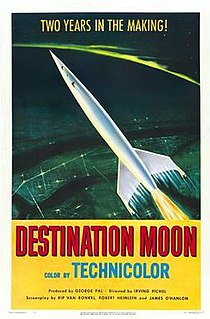
Destination Moon is a 1950 American Technicolor science fiction film, independently produced by George Pal and directed by Irving Pichel, that stars John Archer, Warner Anderson, Tom Powers, and Dick Wesson. The film was distributed in the United States and the United Kingdom by Eagle-Lion Classics.
"Solution Unsatisfactory" is a 1941 science fiction short story by American writer Robert A. Heinlein. It describes the US effort to build a nuclear weapon in order to end the ongoing World War II, and its dystopian consequences to the nation and the world.
"Cripple Fight" is the second episode of the fifth season of the animated television series South Park, and the 67th episode of the series overall. Going by production order, it is the 3rd episode instead of the 2nd. It originally aired in the United States on June 27, 2001 on Comedy Central.

Expanded Universe, The New Worlds of Robert A. Heinlein is a 1980 collection of stories and essays by American writer Robert A. Heinlein. The trade paperback 1981 edition lists the subtitle under other Heinlein books as More Worlds of Robert A. Heinlein because the contents subsume the 1966 Ace Books collection, The Worlds of Robert A. Heinlein. The current volume is dedicated to William Targ.
The science fiction writer Robert A. Heinlein (1907–1988) was productive during a writing career that spanned the last 49 years of his life; the Robert A. Heinlein bibliography includes 32 novels, 59 short stories and 16 collections published during his life. Four films, two TV series, several episodes of a radio series, at least one song and a board game derive more or less directly from his work. He wrote a screenplay for one of the films. Heinlein edited an anthology of other writers' SF short stories.

Scouts BSA is the flagship membership level of the Boy Scouts of America (BSA) for boys and girls between the ages of typically 11 and 17. It provides youth training in character, citizenship, and mental and personal fitness. Scouts are expected to develop personal religious values, learn the principles of American heritage and government, and acquire skills to become successful adults.
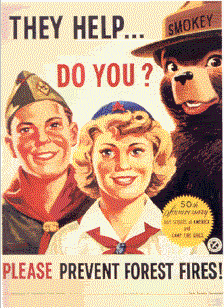
Since Scouting began in 1907, it has entered into many elements of popular culture, including movies, TV and books.

The Boy Scouts of America (BSA) was inspired by and modeled on The Boy Scouts Association, established by Robert Baden-Powell in Britain in 1910. In the early 1900s, several youth organizations were active, and many became part of the BSA.
The Heinlein juveniles are the science fiction novels written by Robert A. Heinlein for Scribner's young-adult line. Each features "a young male protagonist entering the adult world of conflict, decisions, and responsibilities." Together they tell a loosely-connected story of space exploration. Scribner's published the first twelve between 1947 and 1958, but rejected the thirteenth, Starship Troopers. That one was instead published by Putnam. A fourteenth novel, Podkayne of Mars, is sometimes listed as a "Heinlein juvenile", although Heinlein himself did not consider it to be one.

Off the Main Sequence: The Other Science Fiction Stories of Robert A. Heinlein (ISBN 1-58288-184-7) is a collection of 27 short stories by American writer Robert A. Heinlein, including three that were never previously collected in book form.
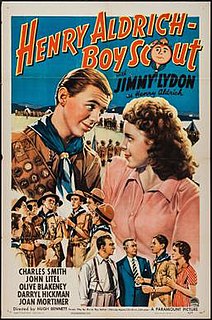
Henry Aldrich, Boy Scout is a 1944 American comedy film directed by Hugh Bennett and written by Muriel Roy Bolton and Agnes Christine Johnston. Ninth in a series of 11 films made between 1939 and 1944 about the Aldrich family and their irrepressible teenage son, Henry, played by Jimmy Lydon, it also stars Charles Smith, John Litel, Olive Blakeney, Joan Mortimer, David Holt, and Minor Watson. Released on January 13, 1944, by Paramount Pictures, it was the first feature film to be made in cooperation with the Boy Scouts of America, who provided a technical advisor to the studio.

A Robert Heinlein Omnibus was a second collection of Robert A Heinlein's stories to use the term "omnibus" the first being The Robert Heinlein Omnibus (1958), published in 1966. Containing fifteen of Heinlein's short stories and novellas, this second "Omnibus" represents a short chronological period, 1940 to 1950, of Heinlein's writings.
References
- ↑ Gifford, 2000, G.074
- 1 2 Expanded Universe (Ace Science Fiction first paperback printing ed.). 1981. p. 276.
- ↑ Gifford, 2000, G.141
- ↑ Alexei Panshin. "THE PERIOD OF SUCCESS - 1949". Heinlein in Dimension.
- ↑ Gifford, 2000, G.193
- ↑ Estimated at least two generations (50 years) past 1995 from story details (a recovered driver's licence).